It takes a village to heal Israel’s abused teen girls
NY philanthropist Susan Ashner celebrates opening of new school at Beit Ruth, marking growth for the holistic therapeutic refuge for young female victims
AFULA — Susan Ashner wasn’t dressed appropriately, but that
didn’t stop her. In white pants and heeled metallic slide sandals, she
carefully stepped her way through a construction site in this northern
Israeli city on a blisteringly hot afternoon this past July.
Sitting down on a randomly strewn cinder block, Ashner took a moment to reflect on this building rising from the ground at Beit Ruth, the unique educational and therapeutic residential village for vulnerable and at-risk teen girls she and her husband Michael Ashner co-founded 14 years ago. The New York philanthropist couple’s dream of a proper school for the residents was coming to fruition.
Flash forward four months, and construction of the $3.4 million facility is now complete. Beit Ruth’s residents have been studying and participating in enrichment programs there since mid-October.

The school has the capacity to accommodate several hundred
residential and day students. It also has a dedicated lecture hall for
Beit Ruth’s advocacy and educational outreach programs on issues related
to at-risk girls for key groups such as teachers, school directors,
medical professionals, and police.
While the school was built with future growth in mind, Beit Ruth currently has only 45 residents, all who appear to the casual observer like typical teenage girls. They dress according to the latest trends, know the lyrics to popular songs, and swoon over famous movie actors and rock stars.
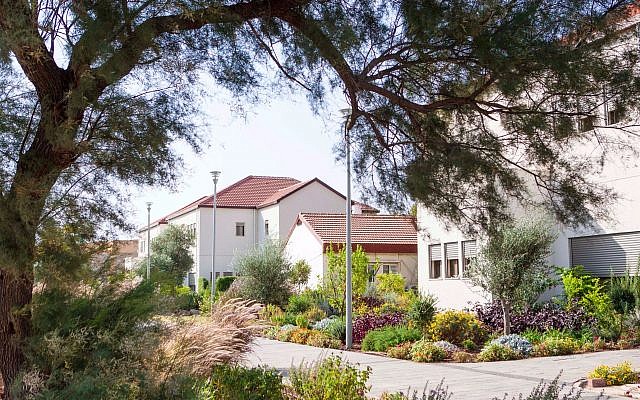
“I could have gotten to the point of my being on the streets if I hadn’t gone to live at Beit Ruth,” said S., a 23-year-old Beit Ruth graduate.
Thanks to individualized academic programs that catch them up on months or years of missed material, Beit Ruth residents graduate high school, some with full matriculation. Many graduates, like S. and D., a 22-year-old Beit Ruth graduate who has returned to live temporarily at the village to mentor younger residents, go on to serve in the IDF and then study at university or work.
At 14, S. did not get along with her mother and was physically, emotionally and sexually abused by her 16-year-old boyfriend. Today things are different for her.
“I have a good relationship with my mother and, although I will remember that boyfriend’s abuse, I don’t have to suffer from it and I know that I didn’t do anything wrong. He did,” S. said.
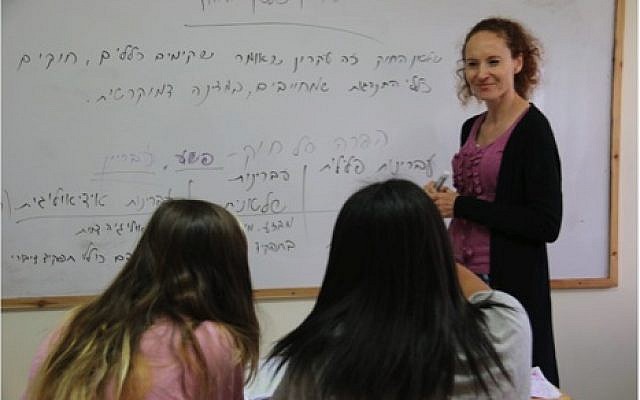
D. is thankful for important life lessons she learned at Beit Ruth.
Among them are the strength to say “no,” recognize her own worth, and
stand her ground and speak up for herself.
“I also know how to take responsibility for both the bad and the good, and to hold myself to high standards,” she said.
“With the girl having been out of school for a year, a social worker approached her and asked her if she wanted to be removed from her home,” said Iris Twerski, Beit Ruth’s managing director. (Beit Ruth is granted physical custody of its residents, while the girls’ parents retain legal custody.According to Twerski, Beit Ruth was the only realistic option for this girl.
“She was traumatized and needed to heal. Girls like this cannot be placed in a boarding school, especially one where there are boys and men. Boys do well in co-ed programs, but girls don’t,” Twerski said.
“We’ve had girls here who have been abused in mixed-gender facilities,” she said.
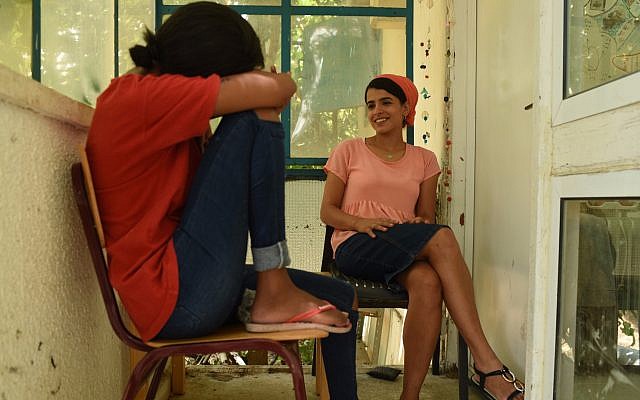
Beit Ruth (Hebrew for “Ruth’s House,” and named for the biblical
heroine) is the only female-led residential village and school in Israel
of its kind.
The country has other residential programs for at-risk girls, but Beit Ruth is the only one where virtually every member of the staff — from the directors to the house coordinators, to the social workers, teachers, therapists and counselors — is a woman.
“A hug from a female counselor is different from a hug from a male counselor,” said mentor D.
The Beit Ruth leadership cites Welfare Ministry statistics that 30,000 teen girls in Israel are at at-risk, of whom 1,000 need to be removed from their homes. There is a shortage of institutions and programs to provide the necessary response to this crisis, and those that do exist have long waiting lists.
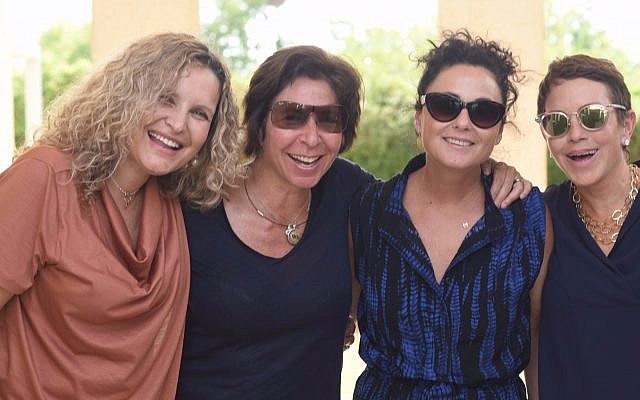
One hundred and ninety girls from all sectors of Israeli society have
resided at Beit Ruth since 2006 (in Afula, and at a prior location in
Rishon Lezion). Many more than the current 45 residents could benefit
from the specialized program. The plan is to triple the village’s
capacity to 150 girls in the not too distant future.
To that end, Beit Ruth’s board is engaged in an $800,000 capital campaign. Board chair Ashner, who together with her husband has to date given $11 million to Beit Ruth, hopes to establish a $35 million endowment to support capital expansions and improvements, and the village’s operating budget.
Seventy percent of Beit Ruth’s $2 million annual operating budget is covered by the Welfare Ministry, with the remainder from donors in the US. WIZO (the Women’s International Zionist Organization) donated the land on which the village was built.
“We work with the girls on values and taking personal responsibility. It’s about giving positive motivation and reinforcement. We never punish unless it’s for violent behavior,” said Twerski.
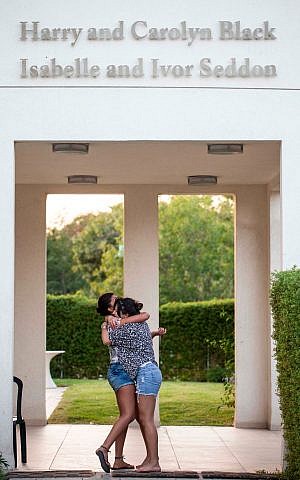
Girls must sign on to a variety of conditions for acceptance to Beit
Ruth, which include participation in all aspects of the village’s
therapeutic program: Academics, enrichment activities (music, drama,
art, sports), psychotherapy, and home life.
The girls do not live in dormitories, but rather in large houses designed and built according to specifications that support the Beit Ruth philosophy. Each two-story group home accommodates up to 15 residents. Upstairs are are five bedrooms (each shared by three girls) and a room for a therapist, who is present every day.
The communal bathrooms are located in the open hallways (deliberately not ensuite within the bedrooms), so that girls with suicidal or self-harm tendencies cannot lock themselves away and out of sight.
The staff-resident ratio is very high, and staff members are present in the houses 24/7 on a rotating basis.
“There is no feeling of hierarchy. The girls can turn to any staff member at any time,” said staff member Mor Ben Simhon-Lipin.
On her visit, Ashner joined the girls in one of the houses for a lunch of roast chicken, roasted vegetables and salads at the long dining table on the main floor, where there are also bathrooms, staff offices, and a living area.
All meals are taken together family-style. A paid cook produces the meals in the kitchen, but the girls are expected to help prepare the food, set the table and clean up. They are equally responsible for keeping all other areas of the house tidy.
“The idea is to give the girls a sense of normalcy, a sense of what it is like to live in a functional family,” said actress Hanna Azoulay Hasfari, who chairs Beit Ruth’s public council and occasionally takes the girls on theater outings.
The one exception to this normalcy is a severe restriction on computer and social media use. Permitted only a half hour per day of social media access, the girls do not walk around staring at smartphone screens like typical teenagers.
“The internet is too dangerous for these girls,” said Ben Simhon-Lipin.
“A girl can deny her trauma. It often takes two years in therapy at Beit Ruth until she faces the issue and deals with it,” said Ben Simhon-Lipin.
The village’s community was rocked earlier this year by the suicide of 22-year-old graduate Avigayil Lavi, who had been a long-term victim of incest.
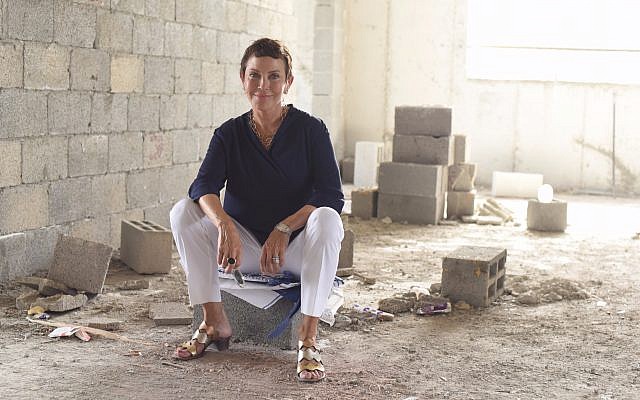
Lavi’s tragic death highlighted the importance of getting girls into
treatment at Beit Ruth as early as possible (Lavi arrived at the village
as an older teen), and of increasing support services for young women
after they age out of Beit Ruth and other programs for 13-18 year olds.
Talk of Lavi brought tears to Ashner’s eyes on her visit to Beit Ruth this summer.
“It is extremely difficult to talk about these things, and about the need for Beit Ruth, but it is so, so important because this could be your sister, or your wife. These girls are the future mothers of Israel,” she said.
Ashner was forthcoming about her love of Israel and her feminism, but less so about events in her own past that drove her to found and sustain Beit Ruth.
“All I will say is that I grew up similar to these girls, and unfortunately I didn’t have a Beit Ruth to go to,” she said.
Sitting down on a randomly strewn cinder block, Ashner took a moment to reflect on this building rising from the ground at Beit Ruth, the unique educational and therapeutic residential village for vulnerable and at-risk teen girls she and her husband Michael Ashner co-founded 14 years ago. The New York philanthropist couple’s dream of a proper school for the residents was coming to fruition.
Flash forward four months, and construction of the $3.4 million facility is now complete. Beit Ruth’s residents have been studying and participating in enrichment programs there since mid-October.

New school building at Beit Ruth village under construction, July 2017
While the school was built with future growth in mind, Beit Ruth currently has only 45 residents, all who appear to the casual observer like typical teenage girls. They dress according to the latest trends, know the lyrics to popular songs, and swoon over famous movie actors and rock stars.

Beit Ruth village, Afula, Israel
But scratch the surface, and heart-wrenching stories are revealed. These girls have been removed from their family homes by court order as a result of severe neglect or physical, sexual or emotional abuse — or any combination thereof. Many are runaways.Beit Ruth, with its holistic therapeutic approach designed specifically to address the needs of at-risk and vulnerable girls, is often these girls’ last — and best — hope for turning their lives around.
But scratch the surface, and heart-wrenching stories are revealed. These girls have been removed from their family homes by court order as a result of severe neglect or physical, sexual or emotional abuse — or any combination thereof. Many are runaways.Beit Ruth, with its holistic therapeutic approach designed specifically to address the needs of at-risk and vulnerable girls, is often these girls’ last — and best — hope for turning their lives around.
“I could have gotten to the point of my being on the streets if I hadn’t gone to live at Beit Ruth,” said S., a 23-year-old Beit Ruth graduate.
Thanks to individualized academic programs that catch them up on months or years of missed material, Beit Ruth residents graduate high school, some with full matriculation. Many graduates, like S. and D., a 22-year-old Beit Ruth graduate who has returned to live temporarily at the village to mentor younger residents, go on to serve in the IDF and then study at university or work.
At 14, S. did not get along with her mother and was physically, emotionally and sexually abused by her 16-year-old boyfriend. Today things are different for her.
“I have a good relationship with my mother and, although I will remember that boyfriend’s abuse, I don’t have to suffer from it and I know that I didn’t do anything wrong. He did,” S. said.

Teacher Orit Ohev Zion teaches a small class at Beit Ruth
“I also know how to take responsibility for both the bad and the good, and to hold myself to high standards,” she said.
From streets to school
Many of Beit Ruth’s 13- to 18-year-old residents have actually been on the streets. One current 13-year-old was using drugs and alcohol and was involved in prostitution at age 12. With her sick, single mother neglectful and her father out of the picture, the girl was victimized by the father of one of her friends, who pimped both girls.
“With the girl having been out of school for a year, a social worker approached her and asked her if she wanted to be removed from her home,” said Iris Twerski, Beit Ruth’s managing director. (Beit Ruth is granted physical custody of its residents, while the girls’ parents retain legal custody.According to Twerski, Beit Ruth was the only realistic option for this girl.
“She was traumatized and needed to heal. Girls like this cannot be placed in a boarding school, especially one where there are boys and men. Boys do well in co-ed programs, but girls don’t,” Twerski said.
“We’ve had girls here who have been abused in mixed-gender facilities,” she said.

Beit Ruth teacher Pnina Amitay speaks with one of her students, July 2017
The country has other residential programs for at-risk girls, but Beit Ruth is the only one where virtually every member of the staff — from the directors to the house coordinators, to the social workers, teachers, therapists and counselors — is a woman.
“A hug from a female counselor is different from a hug from a male counselor,” said mentor D.
The Beit Ruth leadership cites Welfare Ministry statistics that 30,000 teen girls in Israel are at at-risk, of whom 1,000 need to be removed from their homes. There is a shortage of institutions and programs to provide the necessary response to this crisis, and those that do exist have long waiting lists.

From left: Beit Ruth managing director
Iris Twerski, executive director Danielle Burenstein, public council
chair Hanna Azoulay Hasfari, and co-founder and board chair Susan Ashner
at Beit Ruth, Afula, Israel, July 2017.
To that end, Beit Ruth’s board is engaged in an $800,000 capital campaign. Board chair Ashner, who together with her husband has to date given $11 million to Beit Ruth, hopes to establish a $35 million endowment to support capital expansions and improvements, and the village’s operating budget.
Seventy percent of Beit Ruth’s $2 million annual operating budget is covered by the Welfare Ministry, with the remainder from donors in the US. WIZO (the Women’s International Zionist Organization) donated the land on which the village was built.
Free to help themselves
Although girls are directed to Beit Ruth by a court order, there is nothing that compels them to live at the village. Unlike lock-in facilities with security that prevents teenagers from leaving, Beit Ruth is an open facility that relies on mutual trust and cooperation between staff and residents. The girls are free to leave the village at any time, but in reality most are content to be in a self-contained environment where home and school are on the same campus and there is no need to venture out alone.
“We work with the girls on values and taking personal responsibility. It’s about giving positive motivation and reinforcement. We never punish unless it’s for violent behavior,” said Twerski.

Two friends at Beit Ruth hug outside one of the residences at the village
The girls do not live in dormitories, but rather in large houses designed and built according to specifications that support the Beit Ruth philosophy. Each two-story group home accommodates up to 15 residents. Upstairs are are five bedrooms (each shared by three girls) and a room for a therapist, who is present every day.
The communal bathrooms are located in the open hallways (deliberately not ensuite within the bedrooms), so that girls with suicidal or self-harm tendencies cannot lock themselves away and out of sight.
The staff-resident ratio is very high, and staff members are present in the houses 24/7 on a rotating basis.
“There is no feeling of hierarchy. The girls can turn to any staff member at any time,” said staff member Mor Ben Simhon-Lipin.
On her visit, Ashner joined the girls in one of the houses for a lunch of roast chicken, roasted vegetables and salads at the long dining table on the main floor, where there are also bathrooms, staff offices, and a living area.
All meals are taken together family-style. A paid cook produces the meals in the kitchen, but the girls are expected to help prepare the food, set the table and clean up. They are equally responsible for keeping all other areas of the house tidy.
“The idea is to give the girls a sense of normalcy, a sense of what it is like to live in a functional family,” said actress Hanna Azoulay Hasfari, who chairs Beit Ruth’s public council and occasionally takes the girls on theater outings.
The one exception to this normalcy is a severe restriction on computer and social media use. Permitted only a half hour per day of social media access, the girls do not walk around staring at smartphone screens like typical teenagers.
“The internet is too dangerous for these girls,” said Ben Simhon-Lipin.
Haven on a high wire
Beit Ruth is a haven, but it must still abide by Israeli laws and regulations requiring the teenage residents to return home for a visit once every three weeks, if they so desire. Girls may choose to maintain a relationship with their parents, even if going home means putting themselves in a vulnerable position.“A girl can deny her trauma. It often takes two years in therapy at Beit Ruth until she faces the issue and deals with it,” said Ben Simhon-Lipin.
The village’s community was rocked earlier this year by the suicide of 22-year-old graduate Avigayil Lavi, who had been a long-term victim of incest.

Beit Ruth co-founder Susan Ashner at construction site of new school at the village, July 2017
Talk of Lavi brought tears to Ashner’s eyes on her visit to Beit Ruth this summer.
“It is extremely difficult to talk about these things, and about the need for Beit Ruth, but it is so, so important because this could be your sister, or your wife. These girls are the future mothers of Israel,” she said.
Ashner was forthcoming about her love of Israel and her feminism, but less so about events in her own past that drove her to found and sustain Beit Ruth.
“All I will say is that I grew up similar to these girls, and unfortunately I didn’t have a Beit Ruth to go to,” she said.



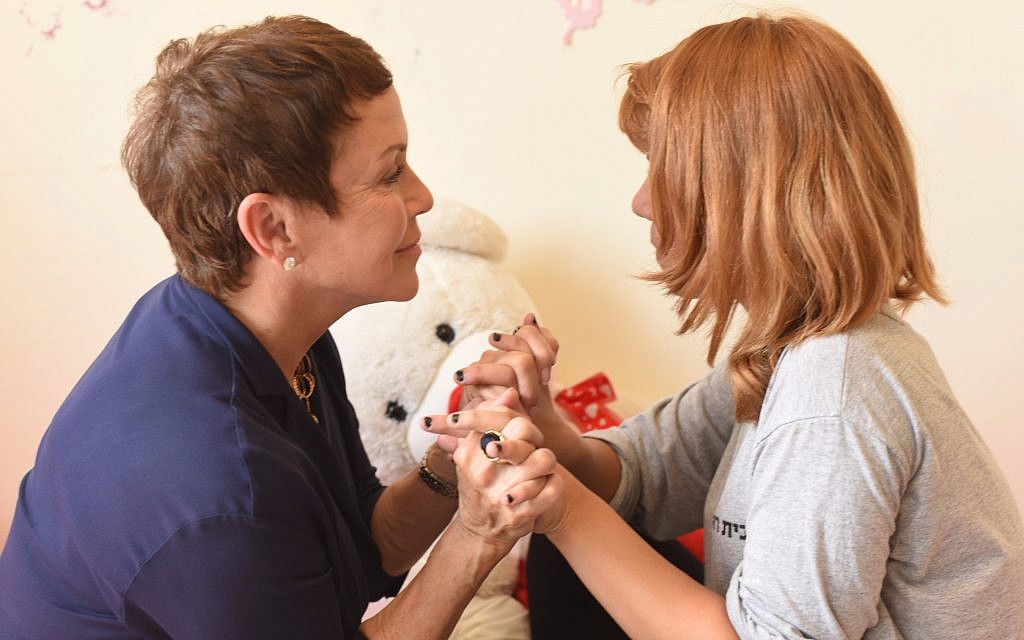
No comments:
Post a Comment